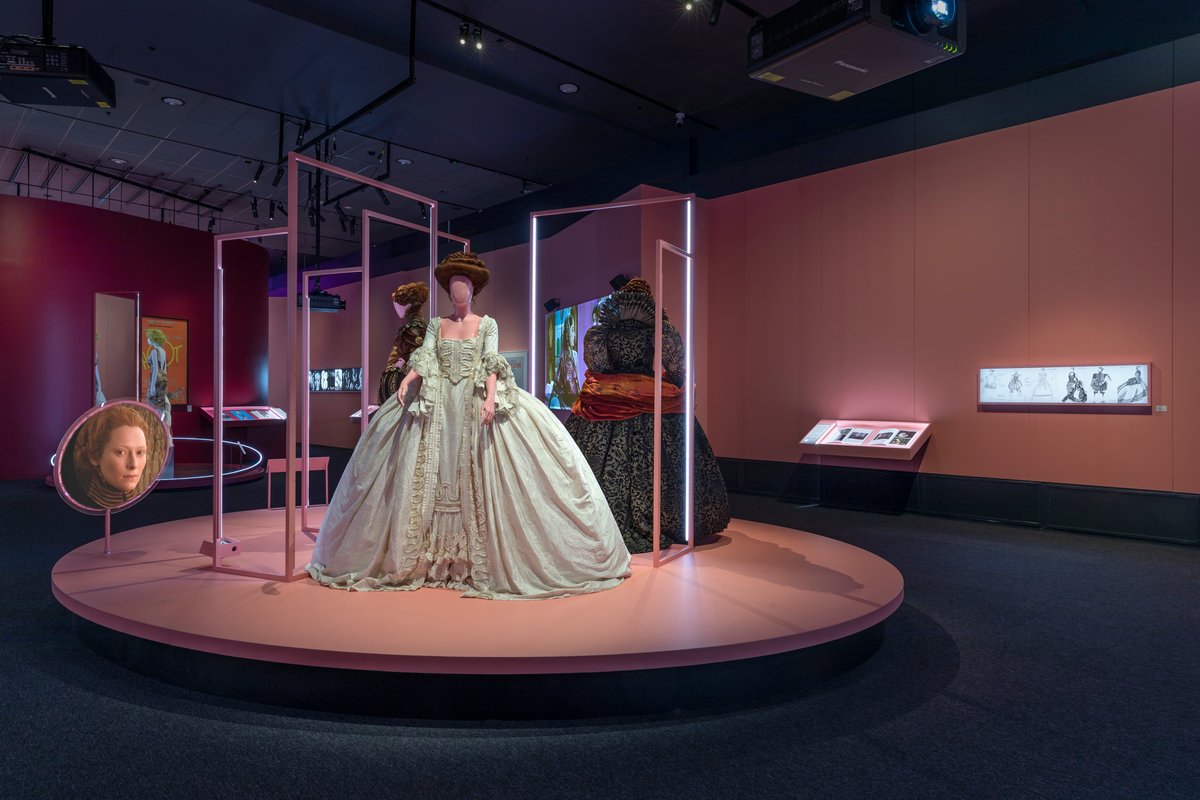With its sumptuous costumes and regal characters, Orlando (1992) – Sally Potter’s adaptation of Virginia Woolf’s 1928 novel – queers the British costume drama to defy the homophobia of the early 1990s. Tilda Swinton stars as the time-travelling, sex-changing Orlando. The story begins in the Tudor period, where we first meet the young nobleman wearing this velvet costume with silk brocade and yellow stockings. Displayed alongside is a costume worn by Quentin Crisp as Queen Elizabeth I. By casting the 83-year-old Crisp, Potter pays tribute to the gay icon, who she described as “the Queen of Queens”.
In one memorable scene, Orlando wakes from a long sleep to discover she is now a woman. “Same person, no difference at all,” says a naked Swinton, breaking the fourth wall to speak directly to the viewer. “Just a different sex.” This transformation isn’t shown as physical, but a fluid shifting of gender identity. Though Orlando embraces her new self, as a woman she’s belittled by high society and has her title challenged and her lands threatened. In this beautiful but imposing white gown, her movement is restricted, symbolising her loss of freedom and agency.
An unexpected mainstream success, Orlando is a landmark work in feminist and LGBTQIA+ cinema, and Swinton’s binary-breaking performance has helped define her persona, allure and influence ever since.
Finding Orlando
Orlando (1992) spans 400 years and takes place across England, Russia and the Middle East. Director Sally Potter faced a unique challenge translating Virginia Woolf’s 1928 era-spanning novel for the screen. For over five years, she and Tilda Swinton worked tirelessly on the script. But when they pitched the idea to funders, they were told that it was “unmakeable, impossible, far too expensive and anyway not interesting”. To help financiers imagine their cinematic vision, the pair took a different tack. They hired period costumes and staged an impromptu photoshoot at a stately home. The ‘look book’ helped illustrate the visual approach to the film. You can see how the photos of a young Swinton led to the film’s iconic subversion of the costume drama.
Legendary costume designer Sandy Powell also lent her creative talents to the film. The rapid lines of her costume sketches capture the anarchistic energy of the production. They also show how the costuming shifts and evolves as Swinton’s character embodies both genders across different eras.
When Swinton guest-edited the magazine Aperture in 2019, she included the images from the look book. A year later, Orlando inspired the 2020 Met Gala theme, demonstrating the film’s enduring impact.
A symbol of liberation
In 1992, when Orlando was released, it was illegal to ‘promote homosexuality’ in Britain under laws passed by Margaret Thatcher’s conservative government in response to the HIV/AIDs epidemic. Despite facing persecution, the author and raconteur Quentin Crisp – one of England’s first openly gay figures – became a queer icon. This black and gold brocade gown worn by Crisp as Queen Elizabeth I recreates the monarch’s famous dress, adorned with eyes and ears to suggest she was always watching and listening. Crisp’s camp interpretation of Elizabeth I turned a symbol of authority into one of liberation. Later in life, Crisp would identify as transgender and use she/her pronouns.
Discover more
The Orlando theatrical trailer via spinteractive1's YouTube channel
Related articles
Related works
Content notification
Our collection comprises over 40,000 moving image works, acquired and catalogued between the 1940s and early 2000s. As a result, some items may reflect outdated, offensive and possibly harmful views and opinions. ACMI is working to identify and redress such usages.
Learn more about our collection and our collection policy here. If you come across harmful content on our website that you would like to report, let us know.
Collection
Not in ACMI's collection
Previously on display
1 October 2023
Australian Centre for the Moving Image
Collection metadata
ACMI Identifier
193586
Curatorial section
Goddess → Breaking the Binary → Orlando
